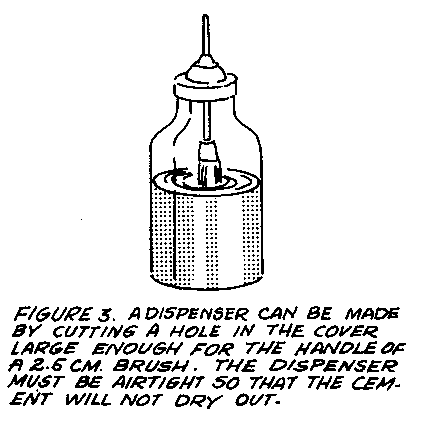Inexpensive rubber cement can be made easily with ordinary gasoline and raw sheet rubber.
Imported pastes are often expensive. Many of these are not good for mounting pictures and similar materials; they soak through the paper and wrinkle both the picture and the mount.
Rubber cement does not wrinkle the pieces to be joined. It has another advantage: if it smears, it can be rubbed off with the fingers when it is dry.
Tools and Materials
Ordinary gasoline: 250cc (16 ounces) Raw sheet rubber in one piece: 5gm (115 ounce) Jar with lid Stirring rod Brown bottle (Tin can Charcoal *Small pieces of cloth
*Needed only if gasoline is colored.
* * * CAUTION * * *
Gasoline will burn and explode, and the vapors can be a health hazard. Be careful when mixing or applying the cement. Do not inhale the gasoline vapors. Make the rubber cement in a well-ventilated place.
The rubber to be used should be a translucent, light-brown sheet. Any brand of gasoline can be used. Some gasolines are highly colored. This coloring should be removed so that the rubber cement will not stain when it is used. To remove the coloring, pour the gasoline over common charcoal several times (see Figure 2).

Use a clean tin can with a hole in the bottom. Put a small piece of cloth in the bottom of the can to keep the charcoal from falling into the filtered gasoline. You may have to change the charcoal several times before the gasoline is clear.
Put the 5 grams (1/5 ounce) of raw sheet rubber in a jar and pour in the 250cc (16 ounces) of ordinary gasoline (see Figure 1). Cover the jar.

It takes about three days for the rubber to dissolve completely in the gasoline. Stir the mixture several times during this period, especially when the mixture becomes thick. If some of the rubber does not dissolve, more stirring will break it up. When the rubber is dissolved, you will have a smooth, milky-colored cement.
To store the rubber cement, it is best to use a brown bottle because the cement will become thin if it is exposed to sunlight for a long time.
Mark the bottle:
DANGER: EXTREMELY FLAMMABLE, HARMFUL OR FATAL IF SWALLOWED
The cement should be kept in a ventilated cupboard when it is not being used.
To make a handy dispenser for the cement: Cut a hole in the cover of the jar, large enough for the handle of a 2.5cm (1") brush (see Figure 3). Push the handle through

the hole and leave the brush in the jar. This should be airtight because the cement hardens quickly when exposed to air.
Source:
Bunyard, Robert J. "Rubber Cement in a Tropical Climate," The Multiplier, Vol. 2, No. 6, July 1956.